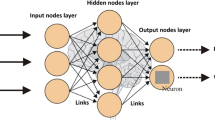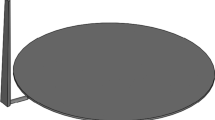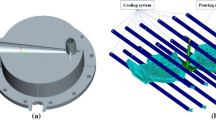Abstract
Warpage and volume shrinkage are important indicators of the quality of thin-walled parts during injection molding. In this study, the optimization goals are warpage and volume shrinkage. Design parameters include mold temperature, melt temperature, injection time, holding time, cooling time, and holding pressure. Based on the orthogonal experimental design and response surface experimental design, the MoldFlow software is applied to the simulation of the thin-walled part injection molding process. The importance of various parameters on warpage and volume shrinkage was analyzed by using analysis of variance. Based on the simulation results, a two-layer hidden-layer back propagation (BP) neural network model is established and the genetic algorithm (GA) is used to optimize the weights and thresholds of the back propagation neural network (BPNN) model to reduce warpage and volume shrinkage by optimizing the design parameters significantly. A support vector machine (SVM) combined with GA-BP was used to build a prediction model for predicting warpage and volume shrinkage. Taking the automobile wire harness protection frame as an example, and verified by numerical simulation, the GA-optimized two-layer hidden-layer BP neural network combination method is an effective method for injection molding to reduce warpage and volume shrinkage of thin-walled parts. SVM-BP-GA can accurately provide predictions for optimization goals; the amount of warpage and the volume shrinkage were 0.93% and 1.9%, respectively.










Similar content being viewed by others
Abbreviations
- BPNN:
-
Back propagation neural network
- GA:
-
Genetic algorithm
- BP:
-
Back propagation
- SOM:
-
Self-organizing competitive neural network
- SOM-BPNN:
-
Self-organizing competitive-back propagation neural network
- PP:
-
Polypropylene
- PS:
-
Polystyrene
- VCM:
-
Variable complexity method
- PIM:
-
Plastic injection molding
- SVM:
-
Support vector machine
- SVM-GA-BP:
-
Support vector machine-genetic algorithm-back propagation
- IEGO:
-
Efficient global optimization
- RBF:
-
Radial basis function
- SAO:
-
Sequential approximation optimization
- SAO-RBF:
-
Sequential approximation optimization-radial basis function
- ANOVA:
-
Analysis of variance
- CNS-GA:
-
Variable complexity method-genetic algorithm
- NSGA-II:
-
Non-dominant use of genetic algorithm
References
Kurtaran H, Ozcelik B, Erzurumlu T (2005) Warpage optimization of a bus ceiling lamp base using neural network model and genetic algorithm. J Mater Process Technol 169(2):314–319
Shen C, Wang L, Li Q (2007) Optimization of injection molding process parameters using combination of artificial neural network and genetic algorithm method. J Mater Process Technol 183(2-3):412–418
Li K, Yan S, Pan W (2016) Warpage optimization of fiber-reinforced composite injection molding by combining back propagation neural network and genetic algorithm. Int J Adv Manuf Technol
Tsai KM, Luo HJ (2015) Comparison of injection molding process windows for plastic lens established by artificial neural network and response surface methodology. Int J Adv Manuf Technol 77(9-12):1599–1611
Chen WC, Tai PH, Wang MW (2008) A neural network-based approach for dynamic quality prediction in a plastic injection molding process. Expert Syst Appl 35(3):843–849
Altan M (2010) Reducing shrinkage in injection moldings via the Taguchi, ANOVA and neural network methods. Mater Des 31(1):599–604
Shi H, Gao Y, Wang X (2010) Optimization of injection molding process parameters using integrated artificial neural network model and expected improvement function method. Int J Adv Manuf Technol 48(9-12):955–962
Shi H, Xie S, Wang X (2013) Warpage optimization method for injection molding using artificial neural network with parametric sampling evaluation strategy. Int J Adv Manuf Technol 65(1-4):343–353
Xu G, Yang ZT, Long GD (2012) Multi-objective optimization of MIMO plastic injection molding process conditions based on particle swarm optimization. Int J Adv Manuf Technol 58(5-8):521–531
Xu G, Yang Z (2015) Multiobjective optimization of process parameters for plastic injection molding via soft computing and grey correlation analysis. Int J Adv Manuf Technol 78(1-4):525–536
Gao Y, Wang X (2008) An effective warpage optimization method in injection molding based on the Kriging model. Int J Adv Manuf Technol 37(9-10):953–960
Wang HS, Wang YN, Wang YC (2013) Cost estimation of plastic injection molding parts through integration of PSO and BP neural network. Expert Syst Appl 40(2):418–428
Zhao P, Zhou H, Li Y (2010) Process parameters optimization of injection molding using a fast strip analysis as a surrogate model. Int J Adv Manuf Technol 49(9-12):949–959
Zhao J, Cheng G, Ruan S (2015) Multi-objective optimization design of injection molding process parameters based on the improved efficient global optimization algorithm and non-dominated sorting-based genetic algorithm. Int J Adv Manuf Technol 78(9-12):1813–1826
Cheng J, Liu Z, Tan J (2013) Multiobjective optimization of injection molding parameters based on soft computing and variable complexity method. Int J Adv Manuf Technol 66(5-8):907–916
Chen WC, Kurniawan D (2014) Process parameters optimization for multiple quality characteristics in plastic injection molding using Taguchi method, BPNN, GA, and hybrid PSO-GA. Int J Precis Eng Manuf 15(8):1583–1593
Kitayama S, Onuki R, Yamazaki K (2014) Warpage reduction with variable pressure profile in plastic injection molding via sequential approximate optimization. Int J Adv Manuf Technol 72(5-8):827–838
Kitayama S, Miyakawa H, Takano M (2017) Multi-objective optimization of injection molding process parameters for short cycle time and warpage reduction using conformal cooling channel. Int J Adv Manuf Technol 88(5-8):1735–1744
Xu Y, Zhang QW, Zhang W (2014) Optimization of injection molding process parameters to improve the mechanical performance of polymer product against impact. Int J Adv Manuf Technol 76(9-12):2199–2208
Author information
Authors and Affiliations
Corresponding author
Additional information
Publisher’s note
Springer Nature remains neutral with regard to jurisdictional claims in published maps and institutional affiliations.
Rights and permissions
About this article
Cite this article
Song, Z., Liu, S., Wang, X. et al. Optimization and prediction of volume shrinkage and warpage of injection-molded thin-walled parts based on neural network. Int J Adv Manuf Technol 109, 755–769 (2020). https://doi.org/10.1007/s00170-020-05558-6
Received:
Accepted:
Published:
Issue Date:
DOI: https://doi.org/10.1007/s00170-020-05558-6




